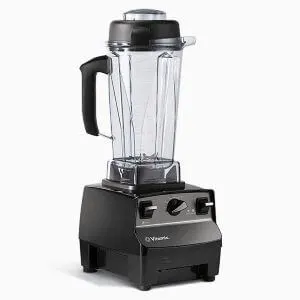 If you are curious about how your blender operates, you have come to the right place. Today we are going to talk all about how your blender functions, and what the motor really does. So, how does a blender motor work?
If you are curious about how your blender operates, you have come to the right place. Today we are going to talk all about how your blender functions, and what the motor really does. So, how does a blender motor work?
Well, the motor of your blender is extremely basic. It is one of the most basic motors around. It is a small electric motor that is cooled using air, and it sits in the blender’s housing unit. This is also known as the motor base.
The motor is situated inside the motor base so that when it is in operation, the motor causes a small vertical coupler shaft to spin very quickly, thereby spinning the blades. Many blenders even use the motor’s motion itself to draw air through the ventilation ports in the housing to keep your motor cool. However, some motors also come with a special fan that will keep them cooler with air flowing over the important internal components.
The big thing to remember with blender motors is that they are not designed for prolonged use. Most blender motors are designed to give the instrument a short burst of serious power. This short burst usually lasts about 60 seconds. It is unusual for a blender motor to last longer than a few minutes without overheating. That’s because there is usually insufficient airflow to cool the motor.
If you keep your motor running continuously, you could end up with an overheating problem. This could cause your motor to shut down temporarily, or to completely fry itself. But this also has to do with what kind of power your motor uses. Small blenders use around 250 watts, while larger and more professional blender motors can operate with 700 watts or more.
Read More: Can You Put Carbonated Drinks in a Blender? Find Out Now!
How Your Motor Controls Blending Speed
Almost every blender in existence is designed to allow for different types of blending speeds. There are blenders that only work with one speed, like the NutriBullet or Magic Bullet, but most blenders have variable speeds. This means the motor is versatile to change how fast your blades are spinning.
Typically, you change the speed of your blender by pushing a button or flicking a switch. When you do this, you alter the amount of power that is output by your motor. If you are blending on low speed, it means only a small amount of power is going to your motor, which slows how fast it spins the coupler, which then slows down the blades.
When you turn your blender on to its highest speed, the full amount of power is then provided to your motor. The coupler spins much faster and the blades become more powerful. Many blenders feature 3 specific motor speeds, allowing you to blend at low, medium, or high speeds. However, you can get blenders with up to 18 different speed settings.
Then there are other settings like crush, liquefy, blend, mix, grind, and so many more. Each setting uses a specific amount of power, which allows your blades to spin at a certain level of quickness.
How Does a Blender Motor Work?
Let’s go through the entire operation of your blender from beginning to end. It starts with you activating the blender using the power switch. Once the motor is activated, it takes power from the electrical outlet and then spins the coupler shaft which is attached to the blender motor. This is the same way most motors work in most tools and appliances.
With your blender running, the shaft spins at the speed you selected, in turn spinning the blades located inside the blender jar. If you take the blade assembly out of the blender jar, you will see something that looks like a gear sticking out of the motor base. This is the coupler. You will notice it fits inside a similar gear-looking component on the underside of the blade assembly.
With the blades spinning inside the blender jar, they create a vortex. If you have liquid inside the blender jar, it is basically like making a whirlwind inside a glass. The blades turn and whirlpool all your liquid ingredients inside the blending jar. This causes solid materials and ingredients to be sucked into the blades, where they are then chopped, circulated back up the vortex, and eventually pulled back down into the blades.
This is why the liquid is so important when creating a smoothie. You need liquid to help create that vortex that pulls ingredients down into the blades. If you only put dry ingredients inside the jar, it is like trying to blend rocks using a lawnmower.
Related Articles:
How Does Pulse Work on a Blender?
The pulse feature is popular on most blenders. It is a little different than the continuous spinning of the blades, and it is usually used for making chunkier recipes, like thick soups or salsas. Not all blenders come with the ability to pulse, but you should definitely keep your eye open for it when shopping around. It could save you lots of hassle and wear on your motor.
You can pulse your motor rather than run it continuously. This will avoid solid ingredients from building up around the blades. Nothing will get stuck under the blades and you won’t have any jams, like when solid ice gets trapped beneath the spinning blades and your motor starts to whine.
The pulse feature is great for anyone who wants a uniform mixture throughout the entire blending jar. It’s basically like turning your blender on and off repeatedly, properly mixing everything at a much slower pace. It can be better for milkshakes and ice cream than continuous blending.
The pulse feature is also a great way to avoid wearing down your blender motor or wearing down the blades. The blades spin to life for just a few seconds, breaking everything up, taking a short break just for a second, then starting again. It pulses your mixture to save power, to save your blades, and to make your blend smoother.
